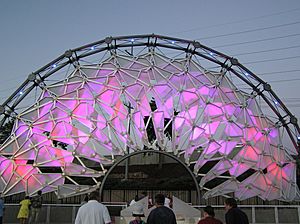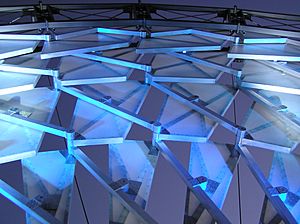Hoberman Arch facts for kids
The Hoberman Arch was a really cool structure that stood in the middle of the Olympic Medals Plaza in downtown Salt Lake City during the 2002 Winter Olympics. It was a main attraction where athletes received their medals. After the Olympics, the arch was moved to the Salt Lake 2002 Olympic Cauldron Park. There, it became a key part of Salt Lake City's Olympic history, along with the Olympic cauldron. In August 2014, the arch was taken down from the park. People are still planning where it might be displayed next.
Contents
What is the Hoberman Arch?
The Hoberman Arch was designed by Chuck Hoberman. It was used as a special curtain for the stage at the Olympic Medal Plaza. This arch was made of aluminum and shaped like a half-circle. It could open and close just like the iris of a human eye. The idea for the arch came from Utah's amazing natural stone arches, like Delicate Arch. When it was built, the Hoberman Arch was the biggest unfolding structure in the whole world!
How Was the Arch Built?
It took Chuck Hoberman four months to design the arch. He had help from a company called Buro Happold. Special parts called "knuckle assemblies" were made in New York. These parts allowed the arch to expand and shrink. Then, all the pieces were put together by Scenic Technologies in New York. They spent another four months building the arch in their warehouse.
After it was built, the arch was taken apart and driven to Utah. It was put back together in January 2002. The Salt Lake Organizing Committee (SLOC) showed it to the public and media on January 25, 2002.
The Arch at the Olympics
When the arch was at the medal plaza, it would open up to show a large 3D sculpture of the 2002 Olympic logo. It also revealed a second Olympic cauldron, called the Hero's Cauldron. The stage was used for medal ceremonies where athletes got their awards. It was also a concert place during the Olympics. Many famous artists played there, like Creed, Brooks & Dunn, and the Dave Matthews Band.
Where Did the Arch Go After the Olympics?
After the Olympics, people started planning where to put the arch. Many people in Salt Lake City wanted it to be used in an outdoor theater or concert area. Places like the Gallivan Center or Pioneer Park were suggested. However, the arch was a symbol of the 2002 games. Because of this, the United States Olympic Committee put rules on where it could go. These rules helped protect the companies that sponsored the Olympics.
Because of these rules and because leaders couldn't agree, SLOC announced a plan on December 5, 2002. They decided to put the arch at the Salt Lake 2002 Olympic Cauldron Park.
On July 30, 2003, three cranes lifted the arch onto its new base at the park. The arch was placed just outside the park's southern fence. It was partly open, so visitors could walk through it. At night, the arch was lit up with many different colors. The arch was taken away from the park in August 2014. Sadly, on December 6, 2014, some parts of the arch were stolen from a storage lot.
Arch Details
The Hoberman Arch was about 36 feet (11 meters) tall and 72 feet (22 meters) wide. It weighed around 31,000 pounds (14,000 kg)! It was made of 4,000 separate pieces. These pieces were put together as 96 connected panels. They were held together with 13,000 steel rivets.
The 96 panels were different sizes. The largest ones were about 9 feet (2.7 meters) tall and 5 feet (1.5 meters) wide. These panels were see-through, which allowed light from behind to shine through. This effect matched the 2002 Olympic theme, which was Light the Fire Within. Two powerful 30-horsepower motors controlled eight cables. These cables pulled the arch open in about 20 seconds. When the arch was fully open, it folded into a 6-foot (1.8-meter) ring that framed the stage.
The arch was built to work even in bad weather. It could handle winds up to 70 miles (110 km) per hour. This was important because of the chance of strong storms during the games.



